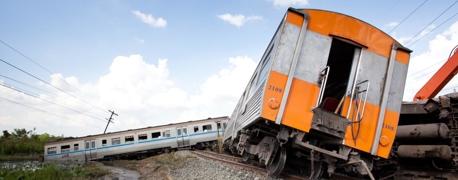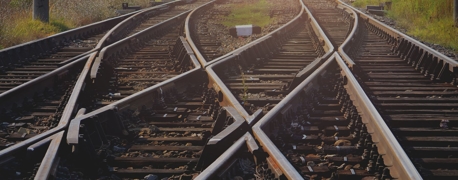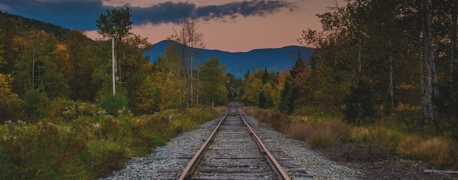Deadliest Train Accidents: The Most Devastating Collisions & Derailments in U.S. History

Since the early 19th century, railways have played an integral role in shaping the United States. Historically, trains have been instrumental in transporting goods and people across the nation, fueling economic progress, expansion, and advancement. Today, rail transportation continues to play a key role in the country’s growth, particularly when it comes to freight transport; trains are essential for moving goods like coal, chemicals, and agricultural products across the nation.
Unfortunately, with all this industry comes a high risk of accidents—often with deadly results.
Over the past two centuries, the U.S. has seen some of the world’s most catastrophic train collisions and derailments, leading to significant losses of life, widespread environmental damage, and billions of dollars in economic losses each year. Despite numerous safety advancements and an overall downward trend in railroad incidents, accidents persist—and they are always preventable.
The Deadliest Train Accidents in U.S. History
Throughout our nation’s history, certain train accidents have been particularly devastating. These tragedies led to unimaginable losses of life, widespread destruction, and untold financial consequences—simply because of negligence.
1876: The Ashtabula, Ohio Train Wreck
On December 29, 1876, a train carrying about 150-200 people plunged into the Ashtabula River outside Ashtabula, Ohio, when the bridge it was crossing suddenly collapsed. Within minutes, overturned oil lamps and heating stoves inside the train cars had set the wreckage ablaze. Many who survived the initial crash died due to the fire, smoke inhalation, and drowning. In total, approximately 92 people were killed, though some estimate the actual count could be as high as 200.
To date, the Ashtabula River railroad disaster remains the deadliest U.S. train accident of the 19th century, and the third-deadliest railroad incident in U.S. history. Historians blame the large number of deaths on several factors, including the “experimental” design of the bridge, a lack of proper bridge construction or maintenance, the failure of the local fire brigade to take any actions to extinguish the flames, and the fact that there was no hospital in Ashtabula at the time.
1904: The Eden Train Wreck
On August 7, 1904, the No. 11 Missouri Pacific Flyer crossed the Dry Creek arroyo bridge on its way from Denver, Colorado, to St. Louis, Missouri. As the train crossed the bridge, a flash flood suddenly surged over the trestle, tearing away the front half of the train and sweeping 88 passengers to their deaths. Later, 22 people were declared missing, and one more passenger ultimately died due to their injuries.
In the aftermath, bodies were recovered as far as 22 miles downriver, and several of the train cars were discovered more than four miles away. The bridge was rebuilt, and train traffic resumed just 24 hours after the crash. The Eden train wreck remains Colorado’s deadliest railroad accident.
1910: The Wellington Avalanche Train Wreck
In the very early morning of March 1, 1910, the small, unincorporated railroad community of Wellington (later renamed Tye) in King County, Washington, experienced the deadliest avalanche in U.S. history. A nine-day blizzard had halted two trains—one mail train and one passenger train—at the railroad depot. Passengers and crew remained aboard, waiting out the storm.
A little after 1 a.m., lightning struck the side of Windy Mountain, sending a 10-foot wall of snow thundering down toward the town. The avalanche hit the railroad depot, flinging the two waiting trains about 150 feet down the hillside. In total, 96 people were killed, including 61 railroad employees and 35 passengers, and just 23 survived.
1918: The Great Train Wreck of 1918
On July 9, 1918, at least 101 people were killed and another 171 injured when two passenger trains hit each other head-on. The collision occurred on a section of the track known as “Dutchman’s Curve” near downtown Nashville, Tennessee. Both trains, which were traveling at about 50 to 60 mph when the crash occurred, derailed and several wooden cars were completely destroyed.
Official reports later attributed the collision to a combination of factors, including human error, improper operating practices, and insufficient enforcement of operating standards. While the official death toll is unknown, some reports indicate it may be as high as 121 people. Today, the Great Train Wreck of 1918, also known as the Dutchman’s Curve train wreck, is widely considered to be the single greatest railroad disaster in U.S. history.
1918: The Malbone Street Wreck
In what remains the deadliest rail disaster in New York State and the New York City Subway’s history, the Malbone Street wreck occurred on November 1, 1918, when a Brooklyn Rapid Transit (BRT) train derailed as it sped around a curve and entered a tunnel below Malbone Street. Despite the fact that the curve was designed to be taken at about 6 mph, the train was estimated to be traveling at 30 to 40 mph at the time of the incident. At least 93 people were killed and more than 100 were injured.
The incident is largely attributed to BRT’s decision to have an inexperienced crew dispatcher, Antonio Edward Luciano, operate the train in order to keep service running despite a strike involving some of the company’s motormen. Both BRT and Luciano were put on trial for manslaughter, and BRT was ordered to pay $1.2 million to victims.
1951: The Woodbridge Train Wreck
On February 6, 1951, an 11-car Pennsylvania Railroad (PRR) train carrying more than 1,000 passengers through Woodbridge, New Jersey, derailed when the engineman rounded a curve at high speeds. At the time of the incident, rail traffic was being diverted from the main line to a temporary stretch of track (known as a shoofly) atop a wooden trestle. Train engineers had been provided notice that the speed limit for the area was 25 mph, rather than the typical 60 mph, but a subsequent investigation found that the PRR train was traveling at about 50 mph when it came to the curve.
Eight of the train’s cars derailed, two of which plunged down a 26-foot embankment, colliding with one another on the way down. Two other cars rolled onto their sides. In total, 85 passengers died, making the Woodbridge train wreck the deadliest train accident in New Jersey history and the deadliest train derailment since 1918.
2008: The Chatsworth Train Collision
In what became the deadliest rail collision in Metrolink’s history, the Chatsworth train collision occurred on September 12, 2008, when a Metrolink commuter train collided head-on with a Union Pacific Railroad freight train in Chatsworth, California. According to an investigation by the National Transportation Safety Board (NTSB), the collision occurred, in part, because the train’s engineer, Robert M. Sanchez, was distracted by sending and receiving text messages while on duty.
The investigation found that Sanchez failed to stop at a red signal and entered a section of single track where the Union Pacific Railroad train, which had been given the right of way, was traveling. Both trains were going about 40 mph when they collided. In total, 25 people—including Sanchez—died and another 135 were injured.
The Worst Railroad Chemical Spills & Hazardous Cargo Disasters
While passenger train accidents are undeniably tragic, non-passenger rail incidents can be equally catastrophic. These events often result in severe environmental damage and pose significant risks to human health, particularly when the trains involved are transporting hazardous materials.
The Lynchburg, Virginia Oil Train Derailment
One of the most disastrous non-passenger train accidents in recent years occurred on April 30, 2014, near Lynchburg, Virginia, when a CSX Transportation freight train went off the tracks. Out of the 17 derailed cars, three were partially submerged in the James River, with one car breaching and releasing about 29,868 gallons of crude oil into the water. The oil ignited, leading to a massive fireball and prompting the evacuation of the surrounding downtown area.
Thankfully, no injuries were reported, either to the public or the crew. However, an investigation by the National Transportation Safety Board (NTSB) determined that the total damages—excluding the cost of environmental remediation—amounted to $1.2 million.
The Mosier, Oregon Derailment
At about noon on June 3, 2016, a 96-car Union Pacific train derailed near Mosier, Oregon. The train, which was transporting Bakken oil from Noth Dakota to a refinery in Tacoma, Washington, left the tracks in the Columbia River Gorge, spilling about 42,000 gallons of oil. The oil caught fire, and by 5 p.m. that evening, loud explosions could be heard coming from the 16 derailed tank cars.
Following the derailment, the City of Mosier was evacuated, and operations at the local sewage treatment plant were temporarily halted. While much of the oil burned off, some entered the Columbia River, and an oil sheen could be seen on the surface of the water the next day.
The East Palestine, Ohio Chemical Spill
The East Palestine, Ohio, train derailment is widely considered the most disastrous, non-passenger railroad accident in modern U.S. history. The incident occurred on February 3, 2023, when a Norfolk Southern freight train carrying hazardous materials—including vinyl chloride, butyl acrylate, and benzene residue—derailed in East Palestine, Ohio. Many of the 38 derailed cars burned for several days, releasing phosgene, hydrogen chloride, and other chemicals into the air. Hazardous materials also entered the ground soil, and residents within one mile of the crash site were evacuated.
In total, 51 cars derailed, 11 of which were tank cars that released approximately 100,000 gallons of hazardous chemicals into the ground and air. Nearby residents reported smelling chemicals for days after the crash, and a 2024 study by the University of Wisconsin-Madison’s National Atmospheric Deposition Program found that toxins released from the burning tank cars polluted the air in 16 states over an area covering 540,000 square miles.
The incident’s impact on the environment was profound. Tens of thousands of animals died, including both pets and wildlife. Hundreds of thousands of tons of contaminated soil were removed from the area, along with nearly 40 million gallons of contaminated water. Lawsuits were filed alleging the death of at least seven people, including one infant, related to the derailment and its aftermath, and countless people sought medical treatment for symptoms related to chemical exposure.
Almost one year after the incident, the total costs associated with the derailment amounted to $1.1 billion.
How Common Are Railroad Accidents?
Railroad transportation remains one of the safest modes of travel. A 2023 report by NPR found that, since 2000, train accidents had decreased overall by 44%. Since the 1970s, train derailments had fallen by more than 75%. Still, we continue to see numerous accidents involving both passenger and freight trains each year across the country.
According to the National Safety Council, 995 people died in railroad-related incidents in 2023, an increase of 10% from the previous year and the highest number of railroad fatalities in the U.S. since 2007. Non-fatal railroad injuries also increased by 3% in 2023, totaling 6,705.
The most common types of railroad accidents include:
- Derailments
- Side collisions
- Highway rail crossings
- Obstructions
- Fires/explosions
- Raking collisions
- Rear-end collisions
- Head-on collisions
In the past five decades, derailments have made up 71% of the 191,052 total train accidents nationwide.
Are Derailments Happening More Often?
In recent years, train derailments have remained relatively consistent. Over the past decade, derailments have generally decreased, save for a slight increase in derailments between 2020 and 2022, according to CNBC.
Certain states see more derailments than others. Between 1975 and 2023, the states with the most train derailments included:
- Illinois: Illinois has had the most derailments of any state since 1975, with 12,958.
- Texas: Texas has the second-highest number of train derailments with 12,841.
- Pennsylvania: Pennsylvania comes in third with 6,512 train derailments since 1975.
Most derailments don’t make the news because they aren’t considered "major events." These incidents often occur in trainyards without any injuries or extensive damage. However, train derailments should never happen. When derailments involve passenger trains, hazardous cargo, or other serious risks to human lives and the environment, the consequences are severe.
Key Factors in Train Accidents & Derailments
All train accidents are preventable. These incidents most often occur due to the negligence of train operators, railroad companies, maintenance crews, station crews, surveyors, manufacturers, and other parties.
Human Error
Human error remains one of the leading causes of train accidents and derailments. Train operators, engineers, station masters, and other railway personnel are responsible for ensuring trains run safely and efficiently. However, poor judgment, fatigue, distraction, lack of training, and miscommunication can all lead to catastrophic wrecks.
Fatigue is a particular concern in the industry, where long shifts and irregular hours can impair concentration and decision-making. In some cases, miscommunication between train crews or with dispatchers leads to misunderstandings about track conditions, speed limits, or changes in routes, often with devastating results. Furthermore, errors made by train engineers and operators—whether in braking, acceleration, or navigating sharp turns—can significantly increase the risk of derailment.
Mechanical Failures
Historically, mechanical failures have been a leading cause of train accidents in the United States and worldwide. Faulty equipment or broken rails can cause a train to derail, especially when infrastructure is not regularly maintained, or when parts are overdue for replacement. For example, a malfunctioning braking system or a wheel defect can cause a train to lose control. Similarly, broken rails, particularly those weakened by wear and tear or environmental factors, can lead to derailments if not detected and repaired.
The U.S. rail system is vast and often relies on aging infrastructure. Proper inspections and maintenance are critical in preventing accidents, but the vast network of tracks and trains operating in the country makes this a challenging task.
Environmental Factors
Natural elements can also play a significant role in train accidents. Extreme weather conditions, like heavy snow, flooding, and even landslides, can pose immediate risks. Railroads are vulnerable to weather-related disruptions, especially when tracks are exposed to flooding, or when snow and ice accumulate, which leads to slippery tracks and possible obstructions. Landslides, which occur most often in hilly or mountainous areas, can cause trains to derail if tracks are blocked or shifted without warning.
Although the weather is uncontrollable, train companies have a responsibility to adequately respond when these environmental factors are present. They must ensure that trains and tracks are well-maintained, routes are altered when necessary, or delays are enforced when rail transportation becomes unsafe.
Infrastructure Challenges
Outdated infrastructure and a lack of investment in the railroad industry have been longstanding challenges in the U.S. While many railroads have modernized their fleets and certain sections of track, much of the system relies on old, poorly maintained infrastructure. Deteriorating rail lines, obsolete signaling systems, and overcrowded tracks are all contributing factors to accidents and derailments.
Railroads across the country face increasing demand as freight traffic grows, sometimes outpacing the capacity of existing systems. Overcrowded railroads increase the risk of accidents, as trains may be forced to operate in close proximity to one another or on tracks that are in poor condition. Investing in infrastructure upgrades, including better track maintenance, updated signaling systems, and improved safety technology, is critical for reducing the likelihood of these incidents.
Who Is Liable When a Train Accident Occurs?
Train accidents and derailments are often the result of negligence, and the responsible parties should be held accountable. But determining liability in these instances can be complex, with multiple parties often to blame.
One way to determine who is liable for a train accident is to examine the cause.
In cases of human error, the railroad company, train operators, or even third-party contractors may be liable if they were negligent in maintaining safety protocols, ensuring proper training and rest periods for employees, following regulations, maintaining equipment, etc. In instances of mechanical failure, the manufacturer of the faulty equipment or the railway company responsible for maintenance may be at fault. For accidents caused by environmental factors, rail companies could still be held accountable if they failed to properly maintain tracks or provide adequate warnings to prevent accidents due to weather-related disruptions.
In some cases, local, state, and federal regulations play a role in determining liability. Government agencies are frequently involved in investigations to assess whether the accident was the result of insufficient infrastructure or a lack of oversight.
The Aftermath of a Train Accident: Rebuilding Lives, Community & Trust
The aftermath of a train accident stretches far beyond the immediate wreckage. The impact is felt not just by the victims and their families but by entire communities, from residents and local businesses to nearby wildlife and the overall environment. These repercussions can reverberate for years.
In the wake of such disasters, those responsible MUST be held accountable. Lack of accountability does nothing but exacerbate victims’ suffering and undermine public trust. Railroad companies, engineers, manufacturers, and other responsible parties must face the consequences of their negligence. No matter what.
- Categories


